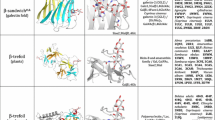Abstract
Leishmania species grown in culture excrete a polyanionic, carbohydrate-rich factor (EF) which binds to antibodies produced in rabbits against the parentLeishmania species. EF, previously purified by physical and chemical methods, was purified by affinity chromatography on aRicinus lectin column. The purified samples were characterised and analysed. The results show a notable proportion of galactose in EF and clarify the reasons for its polyanionic properties. Heterogenicity of EF is demonstrated and discussed.
Similar content being viewed by others
References
Abrahams JC, Zehavi U, Granoth R, Slutzky GM, El-On J, Greenblatt CL (1981) Affinity chromatographic methods for the purification ofLeishmania excreted factor. In: Slutzky GM (ed) Biochemistry of parasites. Pergamon Oxford New York Toronto Sydney Paris Frankfurt, p 171
Adler S, Foner A, Montiglio B (1966) The relationship between human and animal strains ofLeishmania from the Sudan. Trans R Soc Trop Med Hyg 60:380–386
Chen PS Jr, Toribara YT, Warner H (1956) Micro-determination of phosphorus. Anal Chem 28:1756–1758
Clamp JR, Bhatti T, Chambers RE (1971) The determination of carbohydrates in biological materials by gas-liquid chromatography. In: Glick E (ed) Methods of biochemical analysis, Interscience Publihers, New York London Toronto 19:299–344
Dishon T, Slutzky GM, El-On J, Greenblatt CL (1981) Coagglutination and passive haemagglutination in the detection of an excreted immunologically active substance fromLeishmania. Isr J Med Sci 17:245–248
Dobrzhanskaia RS (1975) Method vydeleniia rastvorimogo antigena iz kulturi leishmanii. Medskaya Parazit 44:672–674
Dubois MK, Gilles KA, Hamilton JK, Rebers PA, Smith F (1956) Colorimetric method for determination of sugars and related substances. Anal Chem 28:350–356
Edelstein SJ, Schachman HK (1967) The simultaneous determination of partial specific volumes nnd molecular weights with microgram quantities. J Biol Chem 242:306–311
El-On J, Patton CL (1977) Studies on the interaction of leishmanial excreted factor (EF) with the plant lectins phytohaemagglutinin P and concanavalin A. 5th International Congress of Protozoology New York, p 253
El-On J, Schnur LF (1974) Purification and preliminary characterization of leishmanial excreted factor (EF). J Protozool 21:463–464
El-On J, Bradley DJ, Freeman JC (1979a)Leishmania donovani: The action of excreted factor (EF) upon the hydrolytic enzyme activity of macrophages from mice with genetically different resistance to infection. Exp Parasitol 49:167–174
El-On J, Schnur LF, Greenblatt CL (1979b)Leishmania donovani: physico-chemical, immunoglogical and biological characterization of excreted factor (EF) from promastigotes. Exp Parasitol 47:254–269
El-On J, Zehavi U, Slutzky GM, Abrahams JC, Greenblatt CL (1981) A possible role of leishmanial excreted factor (EF) in the infective process. In: Slutzky GM (ed) Biochemistry of parasites, Pergamon, Oxford New York Toronto Sydney Paris Frankfurt, p 172
El-On J, Pearlman E, Zehavi U, Greenblatt CL (1982) The role of leishmanial surface carbohydrates on attachment of promastigotes to macrophages. J Protozool 29:314
El-On J, Zehavi U, Avraham H, Greenblatt CL (1983)Leishmania tropica andLeishmania donovani: A solid phase radioimmunoassay using leishmanial excreted factor (EF). Exp Parasitol 55:270–279
Greenblatt CL, Kark JD, Schnur LF, Slutzky GM (1981) DoLeishmania serotypes mimic human blood group antigens? Lancet 1:504–505
Jacobson RL, Slutzky GM, Greenblat CL, Schnur LF (1982) Surface reaction ofLeishmania. I. Lectin-mediated agglutination. Ann Trop Med Parasitol 76:45–52
Lowry OH, Rosebrough NJ, Farr AL, Randall RJ (1951) Protein measurement with the folin phenol reagent. J Biol Chem 193:265–275
Patchornik A, Ehrlich-Rogozinski S, Fridkin M (1975) Nonaqueous titration — a useful tool in peptide chemistry. In: Wolman Y (ed) Peptides 1974, Israel University Press, Jerusalem, p 257–269
Schnur LF, Zuckerman A (1976) Excreted factor (EF) serotypes of IsraeliLeishmania. Trans R Soc Trop Med Hyg 70:15
Schnur LF, Zuckerman A (1977) Leishmanial excreted factor (EF) serotypes in Sudan, Kenya and Ethiopia. Ann Trop Med Parasitol 71:273–294
Schnur LF, Zuckerman A, Greenblatt CL (1972) Leishmanial serotypes as distinguished by the gel diffusion factors excreted in vitro and in vivo. Isr J Med Sci 8:932–934
Semprevivo LH, Honigberg BM (1980) Exometabolites ofLeishmania donovani promastigotes. II. Spontaneous changes of exometabolite after isolation. Z Parasitenkd 62:201–211
Sharon N (1975) Complex carbohydrates, Addison-Wesley, London Amsterdam, Don Mills Sydney Tokyo, p 99–103, 215–233
Slutzky GM, Greenblatt CL (1977) Isolation of carbohydrate-rich immunologically active factor from cultures ofLeishmania tropica. FEBS Lett 80:401–404
Slutzky GM, El-On J, Greenblatt CL (1979) The leishmanial excreted factor: Protein-bound and free forms from promastigote cultures ofLeishmania tropica andLeishmania donovani. Infect Immun 26:916–924
Spackman DH (1963) Accelerated system for the automatic analysis of amino acids. Fed Proc 22:244
Spiro RG (1973) Glycoproteins. Adv Protein Chem 27:349–467
Watkins WM (1972) Blood group specific substances. In: Gottschalk A (ed) Glycoproteins, Elsevier, Amsterdam London New York. 2nd ed. Part B, p 830–891
Westphal O, Jann K (1965) Bacterial lipopolysaccharides extraction with phenol-water and further applications of the procedure. In: Whistler RL, BeMiller JN, Wolfrom ML (eds) Methods in carbohydrate chemistry, Academic Press, New York, 5:83–91
Zehavi U, El-On J, Pearlman E, Abrahams JC, Greenblatt CL (1983) Binding ofLeishmania promastigotes to macrophages. Z Parasitenkd 69:405–414
Author information
Authors and Affiliations
Rights and permissions
About this article
Cite this article
Zehavi, U., Abrahams, J.C., Granoth, R. et al. Leishmanial excreted factors (EFs): Purification by affinity chromatography. Z. Parasitenkd. 69, 695–701 (1983). https://doi.org/10.1007/BF00927419
Accepted:
Issue Date:
DOI: https://doi.org/10.1007/BF00927419




